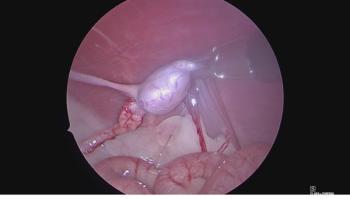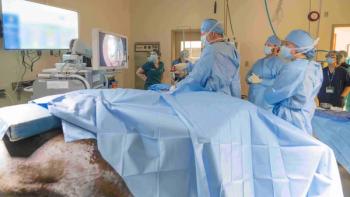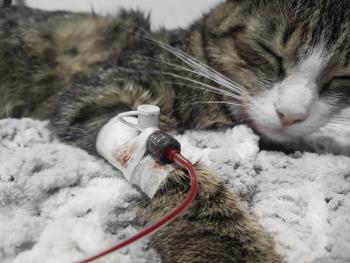
Evaluating and managing HBC patients before surgery (Proceedings)
Thorax: Many dogs with pneumothorax (hemothorax, chylothorax, diaphragmatic hernia, etc) are able to ventilate marginally but adequately when at rest in a cage. The loss of lung/ventilation capacity may not become clinical for several minutes after induction of general anesthesia or during recovery.
There is a tendency to focus on the fracture. Remember that the entire dog was traumatized, not just the bone.
• Perform ABC's 1st !!
• Injuries discussed are either common, life threatening, or may significantly impact the owner's decisions. THESE INJURIES ARE OFTEN OCCULT !!! There is a poor relationship between any of these non-orthopedic injuries and whether a front leg or rear leg was traumatized.
Fill in the blank
Thorax: Many dogs with pneumothorax (hemothorax, chylothorax, diaphragmatic hernia, etc) are able to ventilate marginally but adequately when at rest in a cage. The loss of lung/ventilation capacity may not become clinical for several minutes after induction of general anesthesia or during recovery. Dog may die before understand what is causing the problem and/or correct hypoventilation. Two view radiographs of the chest (preferably unsedated) can rule in or out pneumo or hemothorax, diaphragmatic hernia, and pulmonary contusions.
Traumatic myocarditis (heart contusion): No clinical signs in un-anesthetized patient. Induction of anesthesia causes asystole, not detected unless routinely induce anesthesia with an EKG attached to patient.
• First PVC may occur up to 72 hours after trauma (or may occur immediately).
• Recommend an EKG daily for 2 minutes for 72 hours after trauma if anesthesia is planned.
• Treatment is lidocaine I.V. to effect (CRI) based on lack of PVC's on EKG.
• If dog presented after 72 hrs., must run one EKG to diagnose traumatic myocarditis.
• PVC's last for weeks with traumatic myocarditis. Typically only a problem with anesthesia.
Urinary leakage:
Day 1: no clinical signs of vomit once.
Day 2: vomit once or twice, borderline dehydrated and borderline depressed.
Day 3: vomit 3-4 times, dehydrated, depressed.
Day 4: dead.
Superimpose these clinical signs on a dog that has had major trauma, fractures, shock, and various therapies, and the chances a clinician will detect urinary leakage from clinical signs is slim to none. Ability to urinate, even urine without blood, does not mean there is not a urinary leakage. The most common location for leakage is the urinary bladder, but can be either kidney, ureter(s), bladder, or urethra (some of these are extraperitoneal). Imaging would require IVU, contrast cystogram and contract urethrogram: time and cost prohibitive on every case. Most effective is to run a BUN daily for 4 days after trauma and evaluate for large increases. If large increases are observed, then contrast radiography of the entire urinary system is performed.
Urinary obstruction: may be from blood clot in the urinary bladder, or from urinary bladder so badly contused that the muscle is unable to contract. Treatment is urinary catheter for 5-10 days.
Urinary denervation: Most reliable way to establish normal innervation of the urinary bladder is to observe normal urination. Normal urination is a 1) a sudden start 2) a full stream 3) a sudden stop, and 4) < 10 ml in the bladder (i.e. can not palpate urinary bladder). Urine in cage does not equal normal urination or observed by untrained person is not reliable. Presence of anal tone and anal reflex is good indication that urinary bladder innervation is intact.
Tail fractures or luxations are often associated with urinary bladder denervation. Extreme bruising of ventral abdomen is often associated with urinary bladder rupture. Absence of either of these clinical signs does not mean the denervation/rupture is absent.
Denervation of a traumatized limb can occur with fracture, and occasionally luxations. Evaluation is for complete transection; evaluating for neurapraxia is not practical in the traumatized patient and neurapraxia typically recovers. Evaluation is to pinch the medial and lateral toe and observe that the dog is aware of it (looks, growls, etc). Withdrawal of leg does not indicate the spinal cord is intact, and lack of withdrawal may only mean the muscle of the leg is too bruised to contract. For the rear leg, the lateral toe test sciatic distribution, and the medial to toe test the femoral distribution. For the front leg, the lateral toe test the ulnar distribution and the medial toe test multiple nerves from more cranial in the brachial plexus.
Spinal cord trauma can be evaluated by encouraging the dog to walk (or at least stand) on legs that are normal by orthopedic examination. This should be done prior to sedation, anesthesia, and/or positioning for radiographs. If the dog is unable or unwilling to stand on orthopedically normal legs, unsedated spinal radiographs (lateral evaluated first) should be taken and the status of the spinal cord further evaluated. Sedation removes the dog's last defense to protect an injured spinal cord, namely contraction/spasm of peri-spinal muscles, and this should not be taken away by sedation until the vertebral column is verified to be intact.
The most time consuming and expensive of these base line evaluations is thoracic radiology, and that is not time nor cost prohibitive. Every single dog that has sustained enough trauma to break a bone or luxate a joint should have all of the base line evaluations performed.
Newsletter
From exam room tips to practice management insights, get trusted veterinary news delivered straight to your inbox—subscribe to dvm360.




